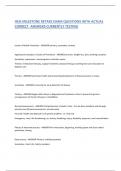HESI MILESTONE RETAKE EXAM QUESTIONS WITH ACTUAL
CORRECT ANSWERS CURRENTLY TESTING
Levels of Health Promotion - ANSWER-primary, secondary, tertiary
Application Examples of Levels of Promotion - ANSWER-primary- weight loss, diet, smoking cessation
Secondary- papsmears, mammograms, testicular exams
Tertiary- medication therapy, surgical treatment, physical therapy, teaching foot care education to
diabetic care
Primary - ANSWER-promotes health and preventing development of disease process or injury
Secondary - ANSWER-screening for early detection of disease
Tertiary - ANSWER-begins after illness is diagnosed and treatment. Aims to prevent long-term
consequences of chronic illnesses or disabilities
Nursing Assessments - ANSWER-Comprehensive- (Head to Toe) = Can be done inpatient and through
primary care (Physical assessment- annual exam)
Focused- Health and physical hx of specific problem.- ex. Sick visit
Emergency- crisis, life threatening. ex. airway, breathing, injury, disability, exposure, med reconciliation
Phases of Interview process - ANSWER-Pre-interaction, beginning, working (open and close ended
questions), closing
Data sources - ANSWER-Primary- individual patient
Secondary- chart info, family members
,Purposes of Documentation - ANSWER-verbal communication, SBAR, written document
Lifespan Nutritional Considerations - Nutrition: Pregnant Women - ANSWER-need additional 300-500
cal/day (whole foods
Lifespan Nutritional Considerations - Nutrition: infants/children - ANSWER-infants/children: whole milk
for ages 2-5 fat intake-brain development
Lifespan Nutritional Considerations - Nutrition: Older - ANSWER-BMR declines, Vitamin D supplements,
Problems: decreased thirst, increase risk for osteoarthritis, osteoporosis, dementia, obesity, social
isolation
General Survey - ANSWER-mental note of overall health (hygiene/appearance). Assessing pain:
documentation, OLDCARTS/OPQRST. Aggravating and alleviating factors, pain goal and funtional goal
Assessing Pain - Documentation - ANSWER-Acute vs. Chronic-Location
Priority - ANSWER-Priority pain: stones (kidney, gallbladder, calcium and/or struvite), myocardial
infarcation (HA), burns and sickle cell
Heart Rate Elevated - ANSWER-above 100 beats per minute
Blood Pressure- Normal - ANSWER-above systolic- 120-129, diastolic- less than 80,
Blood Pressure- elevated - ANSWER-Hypertension: Stage 1: 130-139 or 80-89, Stage Hypertension 2:
more than 140, or greater than or equal to 90
When should BP be taken? - ANSWER-after patient rests for 5 minutues or 30 minutes after caffeine,
smoking
Assessment of the Head and Neck - ANSWER-Inspect, palpate, auscultate
, Infection - ANSWER-If nodes are palpable, warm, tender = infection
Assessment of the Ear - Techniques - ANSWER-Adults: up and back
Children: down and back
Assessment of the Ear - Techniques Part 2 - ANSWER-observe behavioral responses to speech, inspect
ear formation (size, shape & any malformation to the auricle, condition)
Perform whisper test & Rinne test. Pt plug one ear at a time
Perform weber test (evaluate unilateral hearing loss
Assessing the Chest - ANSWER-inspect, palpate, percuss, auscultate
Assessing Lung Sounds - Technique - ANSWER-IPPA- inspect, palpate, percuss, auscultate
Normal Lung Sounds - ANSWER-Normal: bronchial (heard anteriorly) over larynx and trachea
(INSPIRIATION slightly shorter than expiration),
Bronchiovesicular (heard anteriorly and posteriorly)INSPIRATION AND EXPIRATION EQUAL ,
Vesicular (heard both) lower lungs, low pitch, INSPIRATION GREATER THAN EXPIRATION)
Abnormal lung sounds: Rhonchi - ANSWER-low- heard mainly in expiration when pt is breathing out
(made up of one sound- whistle or whine and high pitch, musical instrument sound MULTIPLE sounds-
mainly heard in expiration CONDITION: PNEUMONIA
abnormal lung sounds: stridor - ANSWER-airway obstruction, high pitch whispering or gas (CROUP,
EMERGENCY, EPIGLOTTIS)
Abnormal lung sounds: Crackles - ANSWER-coarse(low pitch, wet sound)
fine (high pitch, doesnt clear w/cough, crackling of fire sound) CONDITION:RESPIRATORY
EDEMA/OBSTRUCTIVE DISEASE




